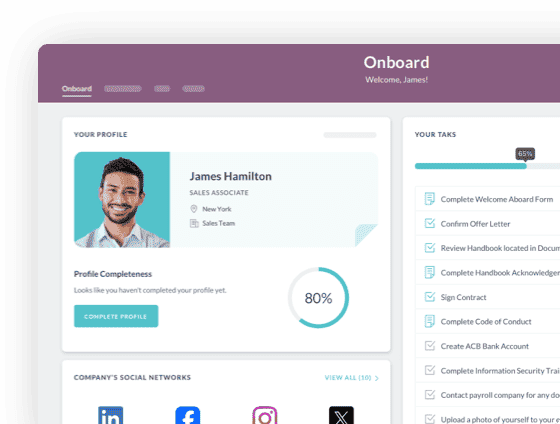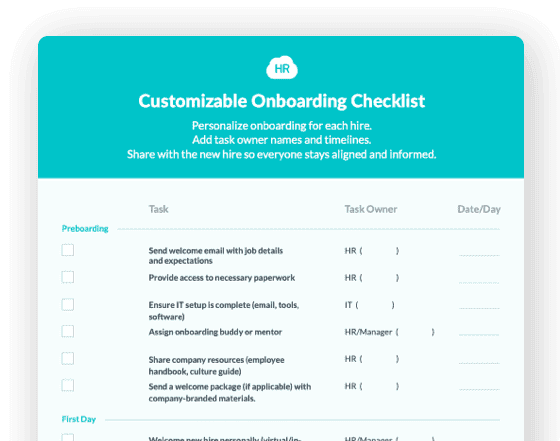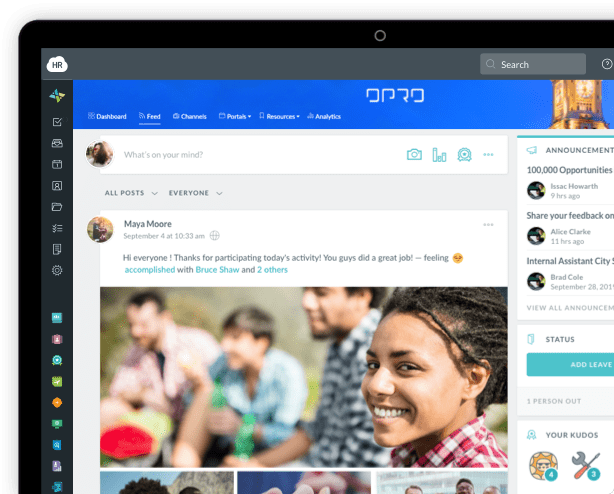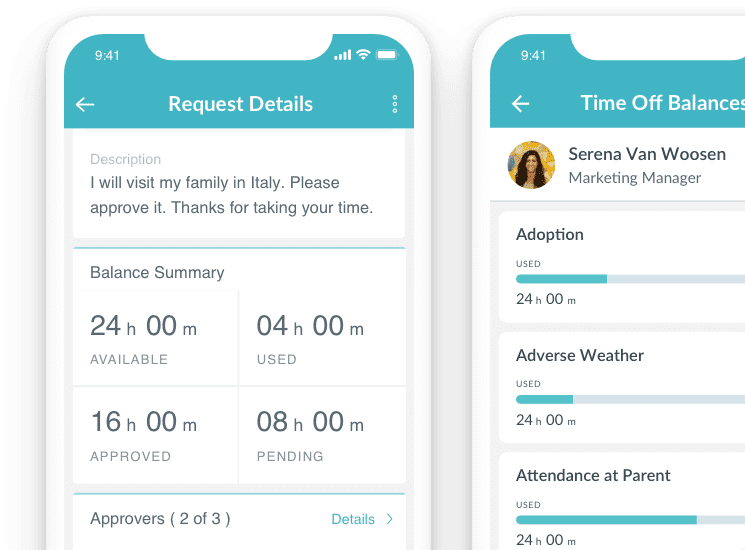- 1. Decide Whether You Need the Meeting or Not
- 2. Great online meeting tools stack
- 3. Get a Prior Check
- 4. Prepare in Advance
- 5. Invite only the associated workforce
- 6. Give different roles to each team member
- 7. Give attention to everyone in the meet
- 8. Be Engaging
- 9. Send a Follow Up
- 10. Check Out Action Items are in Progress
- The Bottom Line


 Cut onboarding time
by 60%—here's the
Ultimate Checklist
that helped do it.
Cut onboarding time
by 60%—here's the
Ultimate Checklist
that helped do it.

Whether it is a startup, MNC, or Fortune 500 company, a team meeting is something that is an integral part of the organization’s culture. From planning the activities, delegation of tasks, giving feedback to appraisal, almost all important matters are discussed in team meetings.
Initially, team meetings were mostly conducted face-to-face between managers and team members. However, with the advent of technology, businesses started having a global team with members scattered all over the globe. For such a diverse team, only an online meeting is a viable option.
In 2020, when the coronavirus pandemic hit the world, even businesses operating within an area had to shift to the ‘work from home model. In such a scenario, the prominence of remote meetings soared.
In today’s era and years to come, it can be ascertained that many businesses would continue to rely on remote meetings. However, remote meetings have their advantages and disadvantages.
As a matter of fact, they could either be productive that would help businesses to make future-focused decisions or soul-crushing events that might drain your day.
A majority of professionals prefer face-to-face meetings as that’s how they have been seeing and living. Many even perceive it to be more productive than remote meetings.
Did you know?
“The average employee spends more than 24 hours in unproductive meetings”.
Well, online meetings can be boring and less productive, but it’s the duty of businesses and managers to change that. Yes, businesses should strive to bring in the element of engagement to remote meetings.
A recent survey indicated that 98% of people felt remote meetings foster relationships between the company and team members. However, that is possible only if the meetings are effective.
How can you deliver effective online meetings? Well, there are many ways you can ensure that. In this post, we have covered the most helpful tips.
Here, we have curated 10 remote meeting hacks that will assist you in establishing an engaging and productive online meeting:
1. Decide Whether You Need the Meeting or Not
Every company has a certain SOP to conduct either daily, weekly, or monthly meetings. We all know that meetings are essential but there are instances when they can be avoided. For example: If you have already discussed everything in a week’s meeting and there’s not much to discuss, you can think of canceling it the following week. This would reduce the monotony.
You should make sure that you schedule a meeting and consider whether it is necessary. Make sure to assess the expense of a meeting in man-hours against the value it is expected to provide. This may appear to be a no-brainer, but it's rather simple with boring meetings because they're already scheduled.
When a meeting is already arranged, employees are more likely to engage and put in their outputs. So, it’s a call that should be made before scheduling any meeting.
2. Great online meeting tools stack
One of the best online meetings includes three essentials you should remember: collaboration, feedback, and connection. When you efficiently maintain these three important aspects, you are likely to feel more engaged while keeping the meeting more productive.
If you are looking for the best online meeting tools stack, then you must choose Google solutions—Docs and Hangouts, and so on. But you can utilize a combination of tools where each software tool is associated with a specific task, which makes them an ideal match.

3. Get a Prior Check
You may know how to turn on the video camera and send a code for participants to enter as they join. However, issues like connectivity errors, server problems, or other unknown errors are inevitable.
Make it a habit to call or go online at least 5 minutes ahead of time so you can set up the facility ahead of time or switch to plan B. Rehearsals for video recording should also be planned ahead of time, as this can cause the computer's operation memory to become overburdened.
Furthermore, the participants can have their share of problems, especially if they are novices in the case of online meetings. Here, you have to come to their rescue.
To troubleshoot such instances, knowing your software and hardware can help you get the most out of your tools and solve problems faster. You can also leverage a business phone system to communicate with them and help them in joining the meet.
4. Prepare in Advance
It takes time and effort to get everyone together for a remote meeting, so don't waste it. Make a list of particular things to cover and stick to it. It is preferable to communicate the agenda with participants ahead of time so that everyone can prepare.
When people are already engaged before the meeting, they don't waste valuable meeting time thinking about ideas and instead come prepared with them.
5. Invite only the associated workforce
Due to the capabilities of the technology and everyone's capacity to contribute to the conversation, holding a remote meeting with a large number of participants is not viable.
Hence, you should begin by practicing with smaller groups of individuals and gradually expand the number as you get to experience with remote management.
If you want to start, then 1-10 people is a good number as if there are a lot of people on the call, there is less chance that you’ll need to engage in the conversation.
6. Give different roles to each team member
Attendees should take turns playing the roles of facilitator, timekeeper, and scribe to record action items and decisions. This aids in ensuring everyone’s participation and in enhancing engagement.
For a recurring meeting, rotate participants' roles from meeting to the meeting, through a game or a draw. In this case, no one would know who will be the timekeeper or scribe taking down the meeting minutes.
Before the online meeting, any type of game usually works well to keep attendees engaged.

7. Give attention to everyone in the meet
It is critical to make everyone feel as though they can contribute to the project. In this regard, reaching out to each person in the room individually or directly asking for their input is an effective technique to get people interested.
Directly soliciting feedback makes team members feel more involved. Also, keep in mind that listeners can only hear one person at a time, so take turns sharing.
Here are a few examples of effective hooks.
- Are you satisfied with it?
- What piques your interest the most, and why?
- Which section is your favorite and which is your least favorite?
- What would you alter if you had the power to? Why?
- What is one item that could make this project more enjoyable for you, and why?
8. Be Engaging
Since the pandemic took over the landscape, online meetings have become an indispensable part of our lives and that’s the reason, it’s incredibly important to make our meetings meaningful and productive.
It's often difficult for the participants to sit through online meetings where they just have to listen and listen. It should be your task to make it entertaining with vibrant dialogue, beautiful visuals, or your meeting customs, as you put in the effort to organize a wonderful meeting. Schedule some time to break the ice and have some fun with icebreaker questions.
9. Send a Follow Up
You should remind participants of the minutes of each meeting. You can send them the meeting's important topics and the overall meeting's direction. This improves their efficiency while also emphasizing the value of remote meetings to your team members.
A follow-up is only successful if it's read, so make the letter or chat message as interesting as possible by including gifs, videos, and humorous photos from the meeting, for example. Make it a habit, and the meeting attendees will look forward to receiving your email following each meeting.

10. Check Out Action Items are in Progress
It's critical to be very explicit and outcome-oriented with performance targets and expectations. You should discuss both individual and team goals as that foster distant working partnerships.
You can discuss the objectives at the meeting and transmit them via a follow-up email. And, don't forget to keep track of them once the meeting is over. What would be the point if it wasn't the case?
The Bottom Line
So, that’s a sum-up to the 10 tips for effective team meetings!
The most difficult aspect of remote meetings is keeping participants engaged and interested. Feel free to use the guidelines and ideas mentioned above to help you solve this difficulty.
It's crucial to remember, though, that thinking outside the box and trying your own solutions can actually help with engagement. So, start brainstorming!!
About Author: This article is written by the Marketing Team of HR Cloud. HR Cloud is a leading global provider of Applicant Tracking, Onboarding, Offboarding, Communications, Engagement, Recognition, and Financial Wellness solutions. Its powerful and user-friendly software eliminates manual/paper processes, increases employee productivity and engagement, improves time and cost savings, and reduces regulatory compliance risk.
Keep Reading
Enterprise HRIS Implementation: Rippling vs HR Cloud Integration Capabilities and Deployment Success
Enterprise HR Software Implementation Comparison
Best Workday Alternatives for Mid-Market Companies in 2026: Complete HRIS Comparison Guide
"We implemented Workday and our HR team still can't figure out half the features six
BambooHR vs HR Cloud: Which HRIS Actually Scales for Growing Companies?
TL;DR: BambooHR's apparent simplicity becomes a major limitation as companies scale past
Like What You Hear?
We'd love to chat with you more about how HR Cloud® can support your business's HR needs. Book Your Free Demo

Build a Culture of Recognition. Boost Engagement. Guaranteed.
Workmates empowers employees to stay informed, connected, and appreciated—whether they’re on the front line, in the office, or remote. Recognition drives 12x higher engagement.Trusted by industry leaders in every sector




Cut Onboarding Costs by 60%.
Take the confusion and follow-ups out of onboarding with automated workflows, digital forms, and structured portals—so new hires ramp faster 3X quicker.Trusted by industry leaders in every sector




.jpg)


